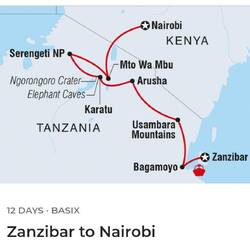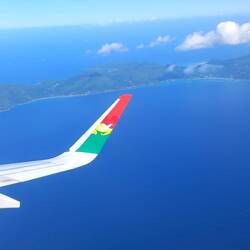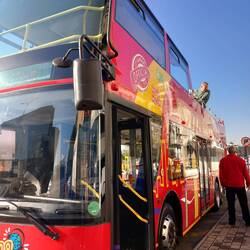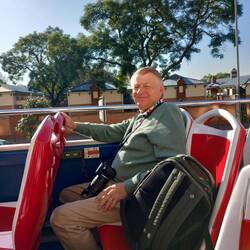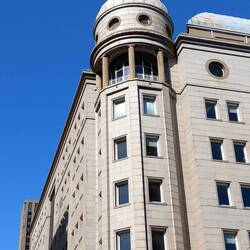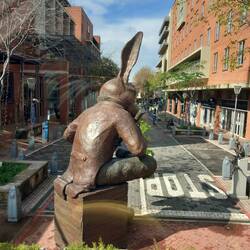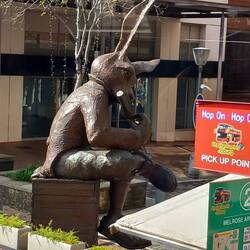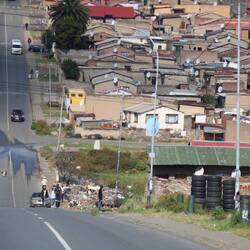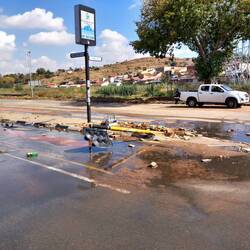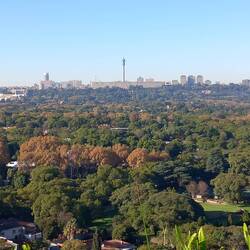The big adventure begins!
 7. mai 2023, Seychellene ⋅ ☀️ 29 °C
7. mai 2023, Seychellene ⋅ ☀️ 29 °C
Today, we are leaving Mahe after almost three weeks of sun, sand, and relaxation. It's been amazing, but we are ready to move on to the next part of the adventure.
And this is the big one!! I can'tLes mer
Photos as we left Seychelles
 7. mai 2023, Seychellene ⋅ ☀️ 29 °C
7. mai 2023, Seychellene ⋅ ☀️ 29 °C
Some photos 📸 taken as we were leaving Seychelles, and as we started tracking the coast of Africa.
Arriving at OR Tambo International
 7. mai 2023, Sør-Afrika
7. mai 2023, Sør-Afrika
We were served lunch on our flight ✈️. I had fish with rice, and Mark had chicken with potatoes. Both were surprisingly good. We both had South African wine to accompany the meal - it would haveLes mer
Transfer to our hotel
 7. mai 2023, Sør-Afrika ⋅ ⛅ 21 °C
7. mai 2023, Sør-Afrika ⋅ ⛅ 21 °C
We had organised a taxi transfer to our hotel. Our driver, Norman, started messaging me while we were still on the plane! We liaised while we were going through security and baggage reclaim (all veryLes mer
Hop-on, hop-off bus
 8. mai 2023, Sør-Afrika ⋅ 🌧 13 °C
8. mai 2023, Sør-Afrika ⋅ 🌧 13 °C
The forecast today was for 90 - 95% chance of heavy rain 🌧 all day! It was unfortunate, but we had pre-booked two-day tickets for the hop-on, hop-off bus 🚌, so we had to go for it!
We headedLes mer
City views
 9. mai 2023, Sør-Afrika ⋅ ☀️ 12 °C
9. mai 2023, Sør-Afrika ⋅ ☀️ 12 °C
Some photos of Johannesburg taken from the city sightseeing bus 🚌.
Another day, another bus ride
 9. mai 2023, Sør-Afrika ⋅ ☀️ 12 °C
9. mai 2023, Sør-Afrika ⋅ ☀️ 12 °C
The weather promised to be much better today with 0% rain forecast, so we were up early to catch the first tourist bus 🚌 of the day, which was due to leave Rosebank Mall at 9am.
The first stop onLes mer
Gold Reef City and the Calabash
 9. mai 2023, Sør-Afrika ⋅ ☀️ 14 °C
9. mai 2023, Sør-Afrika ⋅ ☀️ 14 °C
At the Gold Reef City stop, we transferred to a smaller bus for our tour of Soweto.
The first stop was at the FNB soccer ⚽️ stadium, where the 2010 FIFA World Cup opening and closing ceremoniesLes mer
Soweto tour
 9. mai 2023, Sør-Afrika ⋅ ☀️ 15 °C
9. mai 2023, Sør-Afrika ⋅ ☀️ 15 °C
I was really looking forward to our tour of Soweto. The place has been in my consciousness since I was a teenager and first became aware of the struggle against apartheid. I had an idea in my mind ofLes mer
More photos of Soweto
 9. mai 2023, Sør-Afrika ⋅ ☀️ 16 °C
9. mai 2023, Sør-Afrika ⋅ ☀️ 16 °C
Orlando Towers
 9. mai 2023, Sør-Afrika ⋅ ☀️ 16 °C
9. mai 2023, Sør-Afrika ⋅ ☀️ 16 °C
As part of our tour of Soweto, we stopped at the famous landmark, Orlando Towers.
Orlando Power Station is a decommissioned coal-fired power station. The power station was built at the end of theLes mer
Hector Pieterson Museum
 9. mai 2023, Sør-Afrika ⋅ ☀️ 16 °C
9. mai 2023, Sør-Afrika ⋅ ☀️ 16 °C
Our next stop was at the Hector Pieterson Museum and Memorial. We had an expert guide who told us the familiar story of how Hector, aged 12, was shot and killed at the age of twelve during the SowetoLes mer
Mandela House
 9. mai 2023, Sør-Afrika ⋅ ☀️ 16 °C
9. mai 2023, Sør-Afrika ⋅ ☀️ 16 °C
From the museum, we drove down Vilakazi Street to visit the former home of Nelson Mandela. He lived here from 1946 to 1962. It is a typical four-room 'matchbox' house.
Mandela donated the house toLes mer
Constitution Hill - Number Four Prison
 9. mai 2023, Sør-Afrika ⋅ ☀️ 17 °C
9. mai 2023, Sør-Afrika ⋅ ☀️ 17 °C
From Soweto, we used the City Sightseeing bus again to visit Constitution Hill, a living museum that tells the story of South Africa’s journey to democracy. The site is a former prison and militaryLes mer
More photos of Number Four
 9. mai 2023, Sør-Afrika ⋅ ☀️ 17 °C
9. mai 2023, Sør-Afrika ⋅ ☀️ 17 °C
The Constitutional Court
 9. mai 2023, Sør-Afrika ⋅ ☀️ 18 °C
9. mai 2023, Sør-Afrika ⋅ ☀️ 18 °C
Our tour of Constitution Hill continued with a visit to the Constitutional Court of South Africa 🇿🇦 which is housed in a purpose-built building next door to Number Four. During its construction,Les mer
Some photos of the artwork
 9. mai 2023, Sør-Afrika ⋅ ☀️ 18 °C
9. mai 2023, Sør-Afrika ⋅ ☀️ 18 °C
Here are some photos 📸 of the striking artwork on display in the atrium of the Constitutional Court building. They include a four-panel work by Sipho Ndlovo called 'Images of South African History'.
Women's Prison, Constitution Hill
 9. mai 2023, Sør-Afrika ⋅ ⛅ 18 °C
9. mai 2023, Sør-Afrika ⋅ ⛅ 18 °C
From the Constitutional Court, we walked up to the Women's Jail, built in 1909 in the Victorian style.
On the way, we passed the Flame of Democracy and a statue of a child representing hope.
TheLes mer
The Old Fort on Constitution Hill
 9. mai 2023, Sør-Afrika
9. mai 2023, Sør-Afrika
After the women's jail, we went to visit the Old Fort.
The original prison on Constitution Hill was built to house white male prisoners in 1892. The Old Fort was built around this prison by PaulLes mer
More photos of the Old Fort
 9. mai 2023, Sør-Afrika ⋅ ⛅ 18 °C
9. mai 2023, Sør-Afrika ⋅ ⛅ 18 °C
Before we left Constitution Hill, we visited the Gandhi-Mandela exhibition, which draws parallels between the lives of the two men.
A day at the apartment
 10. mai 2023, Sør-Afrika ⋅ ☀️ 21 °C
10. mai 2023, Sør-Afrika ⋅ ☀️ 21 °C
After a couple of busy days, we decided to spend today at the apartment catching up with posts, listening to the radio, and preparing for the truck 🚚 😂.
The photos attached to this footprintLes mer
A walk around the Mining District
 11. mai 2023, Sør-Afrika ⋅ ☀️ 17 °C
11. mai 2023, Sør-Afrika ⋅ ☀️ 17 °C
We decided to take the City Sightseeing bus 🚌 again today. There were a couple of places we still wanted to see, and the easiest way to get to them was to use the bus 🚌.
Our first stop was theLes mer
More photos of the mining district
 11. mai 2023, Sør-Afrika ⋅ ☀️ 18 °C
11. mai 2023, Sør-Afrika ⋅ ☀️ 18 °C
Mandela's house
 11. mai 2023, Sør-Afrika ⋅ ☀️ 19 °C
11. mai 2023, Sør-Afrika ⋅ ☀️ 19 °C
After our walk, we caught the next bus 🚌 to visit the Apartheid Museum. We were the only passengers! It is winter here, so there are very few tourists about. I don't understand it because theLes mer
Visiting the Apartheid Museum
 11. mai 2023, Sør-Afrika ⋅ ☀️ 21 °C
11. mai 2023, Sør-Afrika ⋅ ☀️ 21 °C
The last place we visited on our City Sightseeing tour was the Apartheid Museum, which opened in 2001. It is recognised as the world's best museum on 20th century South African history. Obviously, itLes mer















